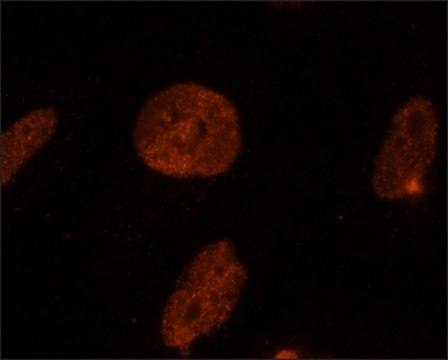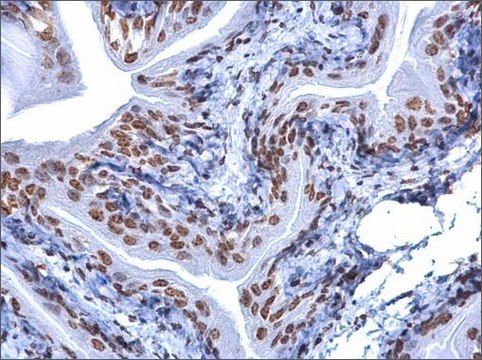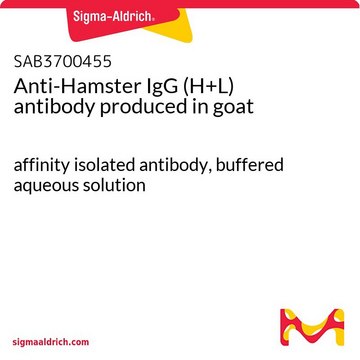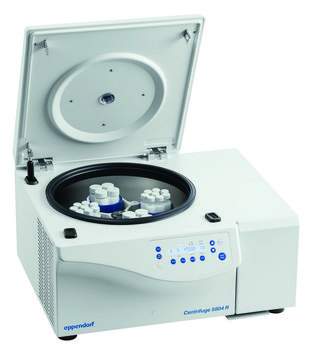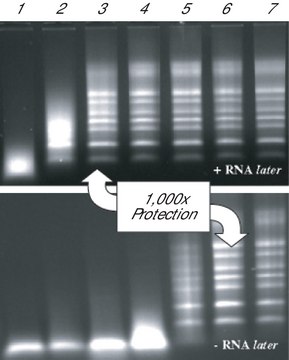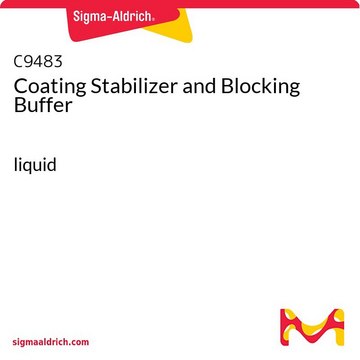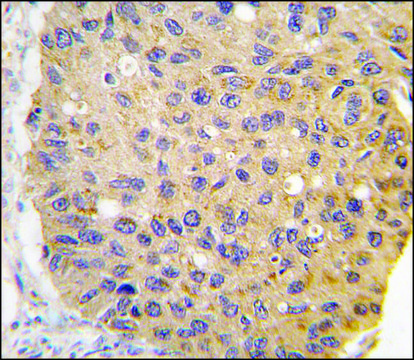SAB4200609
Monoclonal Anti-diMethyl-Histone H3 (diMe-Lys9) (H3K9me2) antibody produced in mouse
~1.0 mg/mL, clone 5E5-G5, purified immunoglobulin
别名:
Anti-H3F3A H3.3A H3F3 PP781 H3F3B H3.3B, Anti-HIST1H3A H3FA, Anti-HIST1H3B H3FL, Anti-HIST1H3C H3FC, Anti-HIST1H3D H3FB, Anti-HIST1H3E H3FD, Anti-HIST1H3F H3FI, Anti-HIST1H3G H3FH, Anti-HIST1H3H H3FK, Anti-HIST1H3I H3FF, Anti-HIST1H3J H3FJ, Anti-HIST2H3A HIST2H3C H3F2 H3FM HIST2H3D
登录查看公司和协议定价
所有图片(2)
About This Item
UNSPSC代码:
12352203
NACRES:
NA.41
推荐产品
生物来源
mouse
质量水平
偶联物
unconjugated
抗体形式
purified immunoglobulin
抗体产品类型
primary antibodies
克隆
5E5-G5, monoclonal
表单
buffered aqueous solution
分子量
antigen ~17 kDa
浓度
~1.0 mg/mL
技术
immunoblotting: 2-4 μg/mL using histones isolated from human HeLa cells.
immunofluorescence: 1-2 μg/mL using human HeLa cells.
同位素/亚型
IgG1
运输
dry ice
储存温度
−20°C
靶向翻译后修饰
dimethylation (Lys9)
一般描述
Monoclonal Anti-diMethyl-Histone H3 (diMe-Lys9) (H3K9me2) (mouse IgG1 isotype) is derived from the hybridoma 5E5-G5 produced by the fusion of mouse myeloma cells and splenocytes from BALB/c mice immunized with a dimethylated (diMe-Lys9) peptide corresponding to the N-terminus of human histone H3, conjugated to KLH. Histones H3 and H4 are the core histones forming nucleosome, which is the fundamental unit of chromatin. H3 and H4 remodified by methylation and are highly methylated in mammalian cells.
免疫原
dimethylated (diMe-Lys9) peptide corresponding to the N-terminus of human histone H3, conjugated to KLH. The isotype is determined by ELISA using Mouse Monoclonal Antibody Isotyping Reagents (Sigma ISO-2).
应用
Monoclonal Anti-diMethyl-Histone H3 (diMe-Lys9) (H3K9me2) antibody produced in mouse may be used in several immunochemical techniques including immunoblotting (~17 kDa) and immunofluorescence.
生化/生理作用
Histones are subjected to extensive covalent modifications, including phosphorylation, methylation, acetylation and ubiquitination thought to play an important role in development and in cancer. Histone methylation, is a complex, dynamic process involving various biological processes including transcriptional regulation, chromatin condensation, mitosis and heterochromatin assembly. Moreover, lysine residues can be mono-, di-, and tri-methylated, adding further complexity to the regulation of chromatin structure. Conserved lysine residues in the N-terminal tail domains of histone H3, Lys4, Lys9 and Lys27 are the preferred sites of methylation. Methylation of H3 at Lys9 is a modification intrinsically linked to epigenetic silencing and heterochromatin assembly.
外形
Solution in 0.01 M phosphate buffered saline, pH 7.4, containing 15 mM sodium azide.
免责声明
Unless otherwise stated in our catalog or other company documentation accompanying the product(s), our products are intended for research use only and are not to be used for any other purpose, which includes but is not limited to, unauthorized commercial uses, in vitro diagnostic uses, ex vivo or in vivo therapeutic uses or any type of consumption or application to humans or animals.
未找到合适的产品?
试试我们的产品选型工具.
储存分类代码
10 - Combustible liquids
闪点(°F)
Not applicable
闪点(°C)
Not applicable
法规信息
新产品
Chromatin modifications and their function
Kouzarides, Tony
Cell, 128(4), 693-705 (2007)
Cancer epigenetics: from mechanism to therapy
Dawson M A and Kouzarides T
Cell, 150(1), 12-27 (2012)
Histone methylation versus histone acetylation: new insights into epigenetic regulation
Rice JC, et al.
Current Opinion in Cell Biology, 13(3), 263-273 (2001)
我们的科学家团队拥有各种研究领域经验,包括生命科学、材料科学、化学合成、色谱、分析及许多其他领域.
联系技术服务部门
